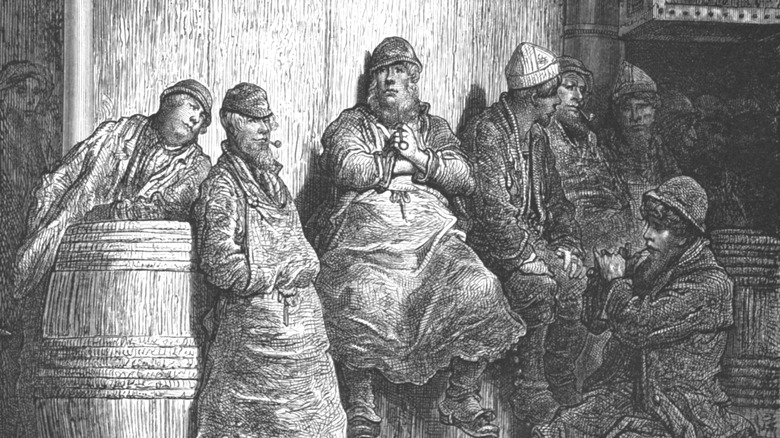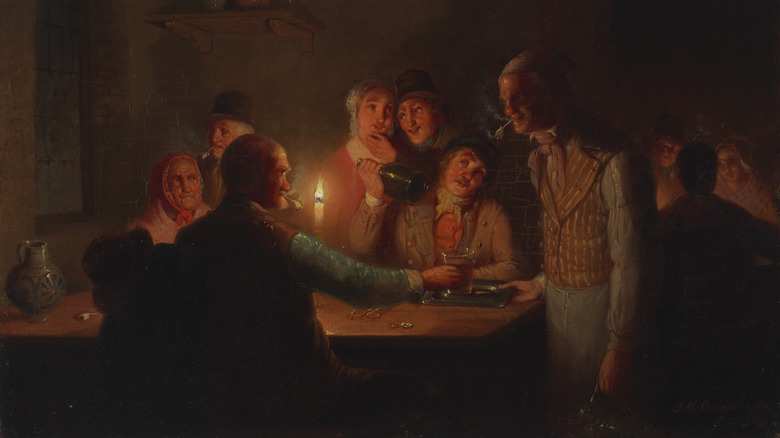The Tragic Story Of The 1900 English Beer Poisoning
In the second half of 1900, a bizarre poisoning case affected northwest England, particularly Manchester, Liverpool, and Salford. Doctors in the area didn't initially notice something was "off," even though many men and women started seeking help for related symptoms (via Groves & Whitnall's Globe Works).
For several months, doctors saw patients complaining of common symptoms such as muscle weakness, a "pins and needles" sensation in the hands and feet, and worsening or appearance of rheumatism signs. As Groves & Whitnall's Globe Works explains, some patients were paralyzed and could not walk anymore. As most of the patients were alcohol drinkers, doctors attributed the symptoms to "alcoholic neuritis" (better known as alcoholic neuropathy today), a condition caused by heavy drinking characterized by pain and tingling in the feet and hands (per Healthline). Soon, however, symptoms appeared in people who did not frequent pub visitors, including a two-year-old. Additionally, people presented a strange skin coloration that was not common in alcoholic neuropathy (via Journal of the Brewery History Society).
By then, doctors also noticed an unusually high number of deaths attributed to alcoholic neuritis — over 41 recorded in four months. The previous seven months only saw 22 attributed to the same cause (per Groves & Whitnall's Globe Works). With the number of cases growing alarmingly fast, doctors now noticed something else: Most cases seemed to be happening to beer drinkers, not spirit drinkers, the Journal of the Brewery History Society reports.
What happened to those getting sick
It was Dr. Ernest Reynolds, who was working at the local Workhouse Infirmary in Manchester, who discovered what was going on. He noticed that all patients shared three common characteristics: Muscle paralysis, issues with the sensory nerves, and discoloration of the skin (per Journal of the Brewery History Society). While the first two are common with alcoholic neuritis (which he believed was usually caused by beer, not other drinks), the third was not. So Reynolds started to look for other common factors among patients.
In a paper published in 1901 in the Medico-Chirurgical Transactions, Reynolds explains that many of the patients he saw were also experiencing herpes zortes, a type of herpesvirus that causes a skin rash (per Medscape). He then figured out that the only known "drug" to cause this type of herpes was arsenic because it was the case of everybody consuming arsenic at high levels. Reynolds suspected arsenic was in the beer; a theory confirmed after he tested the local beer.
After connecting with other doctors and conducting more tests, the common consensus was that the arsenic came from the accidental production of sulphuric acid when processing cane sugar used to produce the beer. This explained why everybody, even those drinking very small amounts of beer (the two-year's father owned a pub and she would get sips of beer there sometimes) were getting poisoned and exhibiting very serious symptoms.
Discovering the cause of the poisoning
Once Reynolds made the connection and it was confirmed the beer was contaminated with arsenic, experts realized there was another problem. The company that produced the contaminated sugars supplied 200 different breweries across the north of England, so stopping production and eliminating the contaminated beer proved tricky (per Medico-Chirurgical Transactions).
Reports state that after a Royal Commission was formed and breweries notified, many started immediately recalling beer already sold and testing all new batches. Thousands of barrels of beer were destroyed. Smaller breweries and those in smaller, faraway towns weren't as quick to eliminate the contaminated batches. Some were still selling poisoned beer two months after the discovery, as reported by the Journal of the Brewery History Society,
Once the patients were diagnosed, Reynolds and the other doctors working with him instructed patients to stop drinking beer and focused on treating the symptoms while waiting for the arsenic to leave their systems. The patients were given small doses of morphine, diuretics, and lotions for skin itching and burning.
By the time it was under control, more than 6,000 people were poisoned and 70 died. However, experts estimate the actual death toll was much higher. Before arsenic was discovered, many patients were likely diagnosed with something else, and their deaths were attributed to alcoholism or liver issues (per Journal of the Brewery History Society).
What happened after
The tragic beer poisoning "epidemic" of 1900 changed very little, legislatively speaking. The Royal Commission's final report indicated that the arsenic likely came from either the malt or the sugars used in the beer brewing process, but this led to no significant changes in the production or testing at breweries or production plants, according to the Journal of the Brewery History Society.
Breweries experienced some difficult financial times for a while, but this was temporary and the industry quickly recovered. In a paper published in Rural History in 1998, experts mention that English farmers were lobbying for about 20 years before the arsenic poisoning incident for tighter control over the quality of ingredients used in beer brewing. While the 1900 beer poisoning epidemic could have been an excellent example of why this was needed, a bill that required statutory control of brewing ingredients was presented. However, it was rejected in 1901.
Perhaps more tragic, no legal repercussions or financial restitutions were made to those affected. According to Reynolds, those seriously affected by the poisoning required months to recover. In the case of the most serious symptoms, like paralysis and motor disturbances, patients needed as long as two years to fully recover (per Medico-Chirurgical Transactions).



